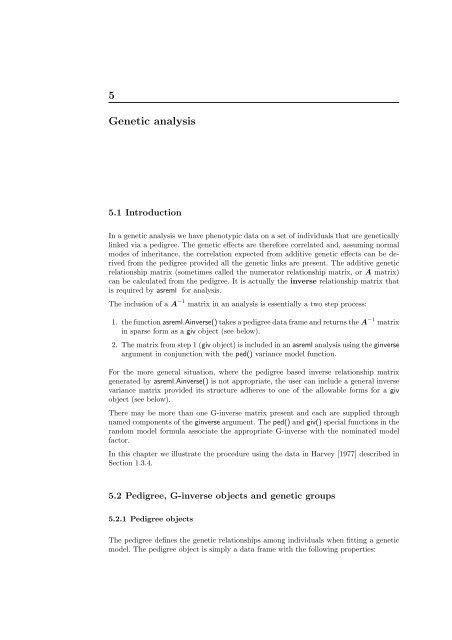ASReml-S reference manual - VSN International
ASReml-S reference manual - VSN International
ASReml-S reference manual - VSN International
- No tags were found...
You also want an ePaper? Increase the reach of your titles
YUMPU automatically turns print PDFs into web optimized ePapers that Google loves.
5Genetic analysis5.1 IntroductionIn a genetic analysis we have phenotypic data on a set of individuals that are geneticallylinked via a pedigree. The genetic effects are therefore correlated and, assuming normalmodes of inheritance, the correlation expected from additive genetic effects can be derivedfrom the pedigree provided all the genetic links are present. The additive geneticrelationship matrix (sometimes called the numerator relationship matrix, or A matrix)can be calculated from the pedigree. It is actually the inverse relationship matrix thatis required by asreml for analysis.The inclusion of a A −1 matrix in an analysis is essentially a two step process:1. the function asreml.Ainverse() takes a pedigree data frame and returns the A −1 matrixin sparse form as a giv object (see below).2. The matrix from step 1 (giv object) is included in an asreml analysis using the ginverseargument in conjunction with the ped() variance model function.For the more general situation, where the pedigree based inverse relationship matrixgenerated by asreml.Ainverse() is not appropriate, the user can include a general inversevariance matrix provided its structure adheres to one of the allowable forms for a givobject (see below).There may be more than one G-inverse matrix present and each are supplied throughnamed components of the ginverse argument. The ped() and giv() special functions in therandom model formula associate the appropriate G-inverse with the nominated modelfactor.In this chapter we illustrate the procedure using the data in Harvey [1977] described inSection 1.3.4.5.2 Pedigree, G-inverse objects and genetic groups5.2.1 Pedigree objectsThe pedigree defines the genetic relationships among individuals when fitting a geneticmodel. The pedigree object is simply a data frame with the following properties:
















